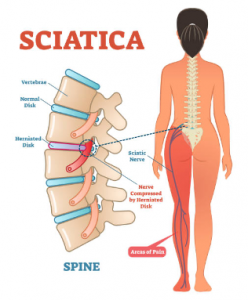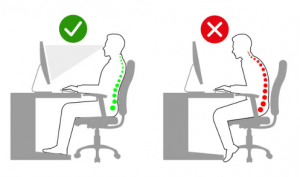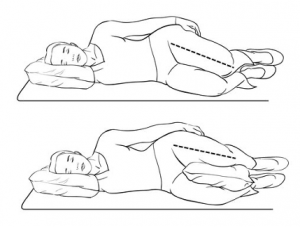Sciatica Physiotherapist in London Specialised in Lower Back Pain. Sciatica physiotherapy treatment in our practice in Clapham, Monument and Belgravia covered by health insurance and Bupa, AXA, Cigna, Allianz recognised
What is Sciatica? How does sciatica happen? Herniated Disc

There are many possible factors that can cause this condition, but around 90% of cases are due to a herniated disc. That’s when an intervertebral disc sticks out abnormally and puts pressure on the sciatic nerve.
However, not all herniated discs result in sciatica. Other common causes include:
- Vertebral osteoarthritis in the lumbar vertebrae
- Trauma to the back
- Vertebral compression due to osteoporosis
- Infection or inflammation near the spine
- Pregnancy (due to sudden weight gain and postural changes)
- Chronic low back pain
- Sports activities that put a strain on the spine
What does a physiotherapist do to treat sciatica? Herniated Disc, Sciatica physio in London
If you’re experiencing back pain that just won’t stop or has become a regular occurrence, it’s time to seek some medical attention. Your doctor can diagnose the issue and refer you to a back and sciatica specialised physiotherapist who can help you get back on track. With proper diagnosis, our sciatica expert physio in London can pinpoint the root cause of your pain and develop a tailored back exercises program to fix the issue along with some hands-on treatment. Not only will this approach alleviate your symptoms, but it can also prevent future occurrences.
When you go for your sciatica physiotherapy treatment session, our back pain physio will work closely with your doctor and review any relevant test results to make sure they get a clear picture of what’s going on. To identify what’s contributing to your back pain, our back expert therapist will ask you questions about your lifestyle, like your occupation, sports, and habitual postures, and then perform a thorough examination of your spine. So, don’t wait any longer to get the help you need to say goodbye to your back pain!
If you are an Axa or Bupa patient, you cannot book online. Please call our office with your authorisation number.
If you cannot find an appointment that suits you, call us or send us a message: we will do our best to find you a slot.
Sciatica & herniated disc physiotherapist in London at our practices in Monument Moorgate EC3, Belgravia SW1 or Clapham SW4.
Our sciatica and herniated disc physiotherapists can treat you at:one of our physiotherapy clinic in London
- Our clinic in Monument near Bank, Moorgate and London Bridge
- Our clinic in Belgravia Westminster near Victoria, Knightsbridge and Sloane Square
- Our 2 clinics in Clapham near Battersea and Balham (Clapham Common and Clapham South)
Our clinics are located within walking distance of the main Central London stations and are easy to reach from anywhere in London. If you cannot find a suitable appointment in your clinic of preference, you can choose any of the others as our clinics are located just 10-15 minutes from each other.
Home Visit Sciatica Physiotherapy in London. Lower Back Pain and Herniated Disc Treatment at Home
In the eventually that the pain in your lower back is too important due to your sciatica or herniated disc and that you have difficulty to come to one of our physio practices in London, we also offer home visit for sciatica physiotherapy where one of our physio will come and treat your Lower back pain from the comfort of your home in London.
Sciatica & herniated disc Physiotherapist covered by Health Insurances and BUPA, AXA Cigna, Allianz registered
Our physiotherapy and osteopathy treatments are covered by most health insurances and are Bupa registered & recognised (BUPA Global and BUPA UK), Axa registered & recognised (AXA International, AXA ppp), Cigna registered & recognised and WPA registered & recognised
For practice and home visit back pain physiotherapy, call: 0207 125 0262 / 0782 455 3765 Or Book online
If you wish to learn more about sciatica, herniated disc and how to treat it you will find in our article bellow the following information:
-
What are the goal of our Sciatica specialised physiotherapy treatment in London at our clinics in Monument, Belgravia and Clapham
-
Why does my lower back hurt?
-
What does sciatica feel like?
-
The Best Ways To Help Relieve Sciatica & herniated Disc Naturally: 5 Tips From Our Sciatica Specialist Physio
What are the goal of our Sciatica specialised physiotherapy treatment in London at our clinics in Monument, Belgravia and Clapham
The objective of the sciatica physio rehabilitation sessions is multifaceted:
- Ease pain, reduce muscle and joint stiffness
- Work on your muscles and balance the muscle chains
- Educate on good practices: postures to adopt and avoid, exercises to practice at home, and pain management.
The number and content of sessions vary depending on your history, lifestyle, and the root cause of your pain. Our back expert physiotherapist will create a custom treatment plan for each patient, which can include exercises and techniques that have been proven to be effective, such as:
- Massages to alleviate muscle tension and contractures related to back pain
- Stretching exercises
- Active exercises to relieve sciatica pain
- Techniques to release muscle tension
- Daily back exercises
- Muscle strengthening exercises to improve muscle tone
If you’d like further information on sciatica physiotherapy rehabilitation, do not hesitate to get in touch by calling on 0207 125 0262 / 07824 553765 or by email at info@babyphysio.com
If you are an Axa or Bupa patient, you cannot book online. Please call our office with your authorisation number.
If you cannot find an appointment that suits you, call us or send us a message: we will do our best to find you a slot.
What You Need To Know About Sciatica: Advices & Exercises From Our Specialised Sciatica Physiotherapist in London
Have you ever experienced the discomfort of back pain? We’ve all been there! Back pain is a common problem that affects many of us at some point in our lives. It can cause discomfort in the upper, middle, or lower back, along with other symptoms, which can make it challenging to go about our daily routines. Dealing with this type of pain can significantly impact our quality of life. When the pain becomes severe, it’s essential to seek the guidance of a healthcare expert such as a doctor or a specialised physiotherapist for sciatica. They can offer the advice and treatment necessary to help alleviate the pain and get you back to enjoying your daily activities pain-free.
Now, it’s important to keep in mind that common back pain is not the same as sciatica. Sciatica is a sneaky pain that starts in your lower back or buttock and then shoots down your leg, sometimes all the way down to your foot. In contrast, back pain is pretty straightforward and sticks to the back region only. So, if you’re dealing with that shooting pain down your leg, it’s time to call in the pros and get that sciatica sorted with a back pain physiotherapist as soon as you can!
Why does my lower back hurt?
Back pain is an issue that affects so many people, and there are a ton of different things that can cause it. Figuring out the root cause of back pain, especially in the lower back, can be like trying to find a needle in a haystack. It’s a tough one to pin down because there are so many different factors that can play a role.
Usually, the pain is caused by mechanical problems, involving various structures in your back like intervertebral discs or posterior joints. This can happen due to trauma or just plain old wear and tear. So, what are the most common culprits that cause back pain?
- Unusual mechanical stress on the spine
When your back is put under a lot of pressure, it can cause what’s known as “lumbago” or being “thrown out back.” This type of pain can come on suddenly and unexpectedly, often caused by things like lifting heavy objects or making sudden movements. But it’s not just about the one-time events; repetitive and constrained movements over time can also contribute to lumbago. If your job involves lifting heavy patients, or children, or working with your arms extended, you might be at a higher risk for this type of back pain.
- Prolonged posture or position
We all have those days where we’re sitting at our desk, hunched over our computer, or driving for hours on end, and before we know it, our back is feeling like it’s been hit by a ton of bricks. That’s because maintaining the same position for an extended period can cause some serious back pain. Even something as seemingly harmless as leaning your head forward while sitting can increase your risk of developing back pain. So, the next time you’re sitting for a long time, make sure to switch up your position and take breaks to stretch those back muscles out. Your back will thank you for it!
- Weakness in the back muscles
Weakness in your back muscles can be a significant contributor to back pain. It’s often caused by a sedentary lifestyle, meaning that if you’re not moving around enough, your muscles can become weak over time. And unfortunately, this weakness can lead to even more back pain. So, make sure to keep those back muscles strong by incorporating some exercises into your routine.
- Mechanical pain
Mechanical pain is the cause of most cases of lower back pain. It’s tricky to figure out which specific structure in your back is causing the pain, making it challenging to treat. But don’t worry, you’re not alone in this. In rare cases, back pain may be a secondary consequence of an underlying condition like an infection, cancerous tumour, ankylosing spondylitis, cardiovascular disease, gastric or duodenal ulcer, and more. So, if you’re experiencing any unusual symptoms or pain, it’s always a good idea to check with a healthcare professional.
What does sciatica feel like?
The symptoms of sciatica may include:
- A stabbing pain that originates from the lower back and spreads to the buttock, back of the thigh, and sometimes the foot. In rare cases, the pain may affect the front of the thigh and the side of the leg, which is called cruralgia.
- Usually, the pain affects only one side of the body, but it can switch sides in tilted sciatica.
- Sitting, standing, coughing, sneezing, or pushing can make the pain worse, while lying down can provide relief.
- Numbness and tingling sensations in the affected leg.
In most cases, sciatica and back pain go hand in hand, known as lumbosciatica, the most frequent form of sciatica.
The Best Ways To Help Relieve Sciatica & herniated Disc Naturally: 5 Tips From Our Sciatica Specialist Physio
-
Avoid sitting for too long it will increase the pain of your lower back

To prevent this from happening, it’s best to avoid sitting for more than half an hour at a stretch. One simple trick is to switch things up by alternating between sitting for 30 minutes and standing for 5 minutes throughout the day. During your standing breaks, you can stretch your legs and move around to get your blood flowing. And if you’re embarking on a long road trip, be sure to schedule frequent stops to take short walks and give your body a break.
-
Be physically active to alleviate the discomfort of Sciatica or herniated disc
If you’re dealing with sciatic nerve pain, there are several physical activities that can help alleviate the discomfort. Swimming, walking, and stationary cycling are great options as they are low-impact exercises that don’t put excessive pressure on your spine. Not only do these activities help with pain relief, but they can also prevent factors that may worsen your condition such as muscle atrophy, osteoarthritis, circulatory problems, loss of mobility, and inflammation.
While rest is important in the acute phase of sciatica, staying sedentary for too long is not the best approach for managing sciatic nerve pain. In fact, moving around as tolerated can help relieve the pain.
-
Pay attention to your posture to avoid increasing your sciatica or herniated disc
Maintaining good posture is crucial in preventing chronic sciatic nerve problems from getting worse. Poor posture can exacerbate the condition, especially when sitting for extended periods. Therefore, it’s important to maintain good posture throughout the day, whether you’re sitting or standing for long periods.
To maintain good posture when sitting, keep your legs parallel and avoid crossing them. Additionally, ensure that you keep your back straight and avoid bending it when you start to feel tired. If you have access to an ergonomist in your company, you can ask them to evaluate your workstation for ergonomic improvements. Our back-specialised physiotherapist can also advise on the right posture to adopt while working at your desk, with relevant exercises that you can do any time of the day at your workplace.
High heels should be avoided to prevent the worsening of sciatic nerve pain, as they increase the curvature of the lower back and can lead to inflammation and stiffness in the calf muscles.

-
Apply ice and heat on your lower back
A combination of ice and heat therapy can be effective in reducing the discomfort of sciatic nerve pain. Alternating between the two can help reduce inflammation, numb the affected area, and relax tight muscles. It’s recommended to start with a 10-minutes ice application on the affected area, followed by 10 minutes of heat on your lower back and upper buttocks. This approach can help to provide relief and improve your overall comfort level.
-
Consult a physiotherapist for sciatica or herniated disc in London
When it comes to sciatic nerve pain, consulting a back and sciatica specialist physio will be a beneficial option. Our back expert physiotherapist can evaluate the specific area(s) where the nerve is irritated or compressed and provide a personalised sciatica rehabilitation plan to address the underlying cause of the pain.
Our London sciatica pain physiotherapists in Belgravia, Monument and Clapham can see you in the comfort of your own home in London or at the following practices:
- Light Centre Belgravia SW1W 9LX
- Light Centre Monument EC3R 8DU
- Light Centre Clapham Common SW4 7SS
- Make Me Feel Pharmacy SW4 9LA
So don’t wait and contact us now to book your appointment, and start your journey towards a pain-free life!: 02071250262
If you are an Axa or Bupa patient, you cannot book online. Please call our office with your authorisation number.
If you cannot find an appointment that suits you, call us or send us a message: we will do our best to find you a slot.

